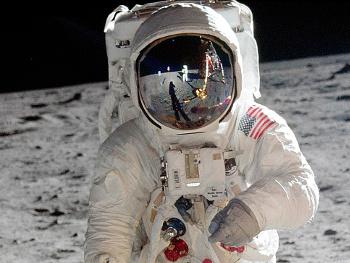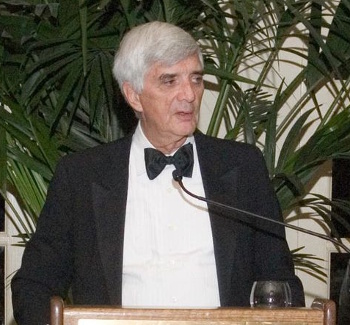Doing it by the Numbers
March 21, 2016
Nearly everyone, when confronted with the
acronym, CPA, will think,
Certified Public Accountant. A very small number will think
Critical Path Analysis, sometimes called the Critical Path Method. This
program management method is a way to find
bottlenecks in a process so that they can be adequately addressed.
Essential elements of what became the Critical Path Method can supposedly be traced back to the
Manhattan Project.
NASA used the Critical Path Method in completing the
Apollo 11 Project that landed the first men on the
Moon. It's reported that this project involved two million tasks,[1] and I can't manage to
shave and eat my
breakfast simultaneously.

Buzz Aldrin of Apollo 11 on the Moon.
The original image was processed to enhance contrast of the faceplate area to reveal the blue dot of Earth, just seen at top edge (Click for larger NASA image).
(March 22, 2005, NASA image.[2]
While project management in those early days was handled using
index cards and huge
wallcharts, project management
applications were among the first types of
software for
desktop computers. A
colleague and I wrestled with one of these applications in the 1980s, since it was a requirement for a
government project. Later, our
employer required the use of
Microsoft Project to generate
Gantt charts for our projects, something that was more hindrance than help when doing
research. I've also used
ProjectLibre, a
free and open source replacement for Microsoft Project.
My
father was a
building contractor who worked in an age before desktop computers. Even if his
career had extended into today's reign of
ubiquitous computing, he would still have used his version of program management that he called "doing it by the numbers." What he meant by this was that a daunting task like building a
house from its
foundation up is actually a series of small tasks. You start with task no. 1, and continue through all tasks until the house is built.
I was reminded of program management when I read
Robert Lucky's article, "Planning for Greatness," in the January, 2016, issue of the
IEEE Spectrum.[3] This article is a
commentary on the
book, "Why Greatness Cannot Be Planned: The Myth of the Objective," by
Kenneth O. Stanley, an
associate professor of
computer science at the
University of Central Florida, and
Joel Lehman, an
assistant professor at the
IT University of Copenhagen participating in
robotics and
computer games research.[4] The
thesis of the book is that setting
objectives for projects discourages
innovation.

Robert W. Lucky.
Lucky, a Bell Labs alumnus who was a vice president at Telcordia Technologies, is a well known electrical engineer and a member of the National Academy of Engineering.
(Via Wikimedia Commons.)
In the Apollo program, there was definitely a goal of putting a man on the Moon, thus, all the attention given to program management. Every
engineering project, from building a
bridge to producing the next generation
computer chip, has a goal. As Lucky correctly observes, you're not going to write a winning
proposal if a goal is not included.
Stanley and Lehman write that innovation can't come from projects that state a objective. I think the problem rests with the definition of the objective. If the objective reads like a
specification for a
bolt, in the end you'll get a bolt. As Lucky writes, if the objective is
wireless communication (
Marconi) or a
solid state replacement for the
vacuum tube (
John Bardeen,
Walter Brattain, and
William Shockley), innovation will result, since the path to the objective has not be etched into a
stone Gantt chart.
One feature of the Stanley-Lehman
model is that
progress supposedly arises through the intermediate step of creation of a series of stable points that they call "stepping stones." These stepping stones are created by a type of engineering that might be called "normal engineering" (c.f.
Kuhn's "
normal science" in
The Structure of Scientific Revolutions).[5] Innovation is created by assembling these stepping stones into a new
product not foreshadowed by any objective.
.jpg)
One person who believed in something like the stepping stone principle was Isaac Newton (1642-1727).
In a 1676 letter to Robert Hooke, Newton wrote, "If I have seen further it is by standing on ye sholders of Giants."[6]
(A 1689 portrait of Newton by Godfrey Kneller (1646–1723), via Wikimedia Commons.)
While Stanley and Lehman seem to advocate a near
willy-nilly exploration in
science and engineering just to build more stepping stones in the hope that they will eventually be useful, this approach can be reconciled with the usual program management scheme. We just need to equate the stepping stones with perceived tasks needed to complete a desired, but
nebulous goal, as in the
radio and
transistor examples above. In this case, the
timeline is as nebulous as the goal, and we're talking about really large projects of the type that Bell Labs once funded, but no longer exist.
In the
1990s, NASA
administrator,
Dan Goldin, introduced a "Faster, Better, Cheaper" initiative designed to improve NASA programs by reducing their
complexity.[7] This approach seemed to work, and the reason it did work is that programs were allowed to fail; that is, the objective would be nice to have, if you could do it, so just try your best. The similarity of this to the objective-free approach of Stanley and Lehman is apparent.
References:
- Pedram Daneshmand, "Birth of the Critical Path Method," projectmanager.com.au, February 10, 2011.
- Apollo Lunar Surface Journal, NASA Web Site.
- Robert W. Lucky, "Planning for Greatness - Should we try for great leaps over incremental advances?" IEEE Spectrum, (January, 2016, print issue, posted December 22, 2015).
- Kenneth O Stanley and Joel Lehman, "Why Greatness Cannot Be Planned: The Myth of the Objective," (Springer, May 5, 2015), 141 pp., ISBN-13: 978-3319155234 (via Amazon).
- Thomas S. Kuhn, "The Structure of Scientific Revolutions: 50th Anniversary Edition," (University Of Chicago Press, April 30, 2012), 264 pp., ISBN-13: 978-0226458120 (via Amazon).
- David Brewster, "Memoirs of the Life, Writings, and Discoveries of Sir Isaac Newton, vol. 1 (Edinburgh: 1855)," Chapter VI, The Newton Project, September 2009.
- Dan Ward, "NASA Finally Figured Out How to Develop Technology—Then Promptly Forgot," medium.com, August 26, 2013.
Permanent Link to this article
Linked Keywords: Acronym; Certified Public Accountant; Critical Path Analysis; program management; bottleneck; Manhattan Project; NASA; Apollo 11 Project; Moon; shaving; shave; breakfast; Eric Nelson; contrast; flight helmet; faceplate; Earth; index card; wallchart; application software; software; desktop computer; collaboration; colleague; government; employer; Microsoft Project; Gantt chart; research; ProjectLibre; free and open source software; father; building contractor; career; ubiquitous computing; house; foundation; Robert W. Lucky; IEEE Spectrum; criticism; commentary; book; Kenneth O. Stanley; associate professor; computer science; University of Central Florida; Joel Lehman; assistant professor; IT University of Copenhagen; robotics; computer game; thesis statement; goal; objective; innovation; Bell Labs; alumnus; vice president; Telcordia Technologies; electrical engineering; electrical engineer; National Academy of Engineering; Wikimedia Commons; engineering; bridge; integrated circuit; computer chip; research proposal; specification; screw; bolt; wireless telegraphy; wireless communication; Guglielmo Marconi; solid state; vacuum tube; John Bardeen; Walter Brattain; William Shockley; monument; stone; conceptual model; progress; Thomas S. Kuhn; normal science; The Structure of Scientific Revolutions; product; Isaac Newton (1642-1727); letter; Robert Hooke; portrait; Godfrey Kneller (1646–1723); willy-nilly; science; nebulous; radio; transistor; timeline; 1990s; administrator; Daniel Goldin; complexity.